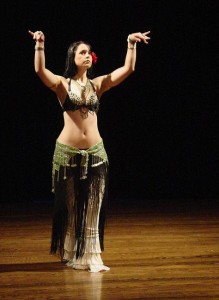On a rare night out, I went to a club with a couple of friends and enjoyed some time on the dance floor as well as off it. The music was largely EDM (electronic dance music, for those not familiar with the folkspeech of its fans) and dubstep, which is both fun and difficult to dance to, because of the interesting way that the rhythm and other sounds interact in the music.
As someone with over 14 years of dance experience, I can navigate a dance floor pretty competently, no matter what the genre of music is. But I got to thinking about how we dance when in uncertain situations, like with unexpected types of music or an unfamiliar environment (maybe when a stage is uneven) or other variables.
To me, it really comes down to form and intention. By “form” I mean posture, technique, and how exactly we choose to structure our movements. At the very least, I endeavor to have excellent posture when I dance, and also when I’m not dancing. I spend a lot of time with my laptop, so I try to make sure I’m not hunching too horribly during those hours. Posture conveys confidence, and good posture is the foundation of a solid dance technique that is both safe for you as a performer and more conducive to creating compelling experiences for the audience.
Since the only style of dance I’m teaching right now is American Tribal Style® Belly Dance, I think about posture a lot in those terms. Having the proper posture is what frees up your spine and hips to undulate, lift, and drop. It’s really amazing what adjusting your posture can do for your dancing.
So, even when I have no idea what the hell is happening with the music I’m dancing to, I check in with my posture a lot to make sure my chest is lifted, my hips are tucked, and my arms are appropriately angled, strong, and elegant. In theory, good posture is itself a thing of beauty, and a dancer could simply stand in good posture for long moments and still hold the audience’s attention, having in that moment transformed herself into a statue-like thing of beauty.
Intention is the other part of the equation. Intention means moving when you mean to move, and being still when you mean to be still. It means directing your gaze in order to direct your audience’s gaze (it always amazes me how linked the two are!). It means giving each movement your full attention so that no motion is ever wasted or extraneous. It means sometimes being minimalist, and sometimes being a whirlwind of activity…but whatever you are doing, you’re doing it on purpose, with an intensity that comes from being in the moment.
When a dancer manages to incorporate both form and intention into a performance, it can be stunning. If a dance is simple in terms of form, but fully developed in terms of intention, I’m guaranteed to love it. Doing things the other way around is more of a gamble. This is one reason I’ve always felt lukewarm about belly dancers who learn the choreographies of others to perform; I feel like it’s harder to be as fully invested in intentionally dancing when the moves aren’t originally your own, and when you’re having to remember something that came from someone else. But this could also be a symptom of the fact that I really dislike memorizing things. And there are certainly a number of talented, beautiful, compelling dancers who perform the choreographies of others, so I don’t mean to disparage them here. This is more of a “this is what works for me as a dancer” post, and I’d be curious to hear the thoughts of others.
Of course, as a folklore scholar, I’m tempted to add more terms and themes to the discussion. For instance, I frequently tell my folklore students that we can identify a genre by looking at four elements: content, context, form, and function. So in an intellectual sense, I don’t think that form and intention alone are adequate to helping us understand what’s going on in a creative performance. But as a dancer, and as someone wanting to keep it simple for my dance students, I’m going to stick with form and intention for now.

